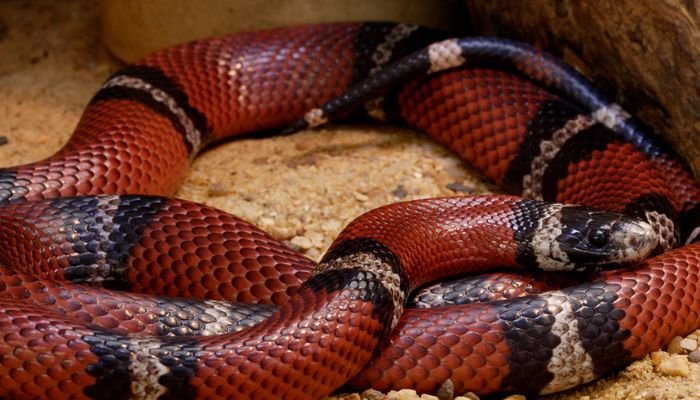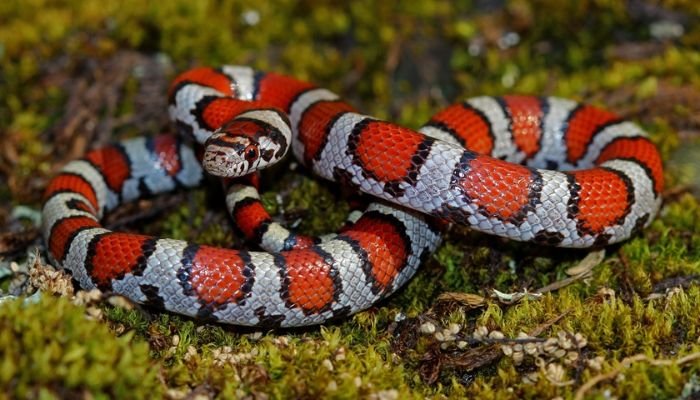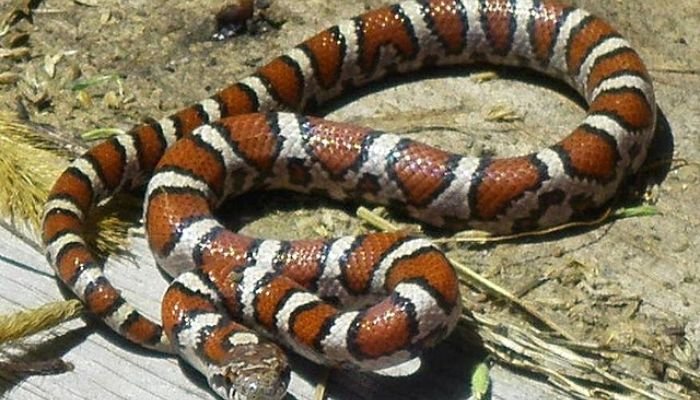
The colorful and non-venomous milk snake is a North and Central American snake species. Due to its unusual banding pattern and vibrant coloring, the Milk Snake is often misidentified for venomous coral snakes. This constrictor’s prey includes tiny mammals, birds, and reptiles. Milk snakes are favored by reptile enthusiasts due to their placid temperament. The primary objectives of conservation efforts are to preserve their natural habitats and increase public awareness of the importance of these snakes in maintaining rodent populations.. Here are Milk snake Guide on Food, Habitat, Size, Lifespan & Predators below-
Milk snake Stats in Table format
The stats are given below for Milk snake
| Reptiles List | Milk snake |
|---|---|
| Family | Colubridae |
| Type | Snake |
| Size | Medium |
| Length | Milk snake: Up to 2-4 feet (0.6-1.2 meters) |
| Color | Milk snake: The color varies depending on the subspecies, but milk snakes can have a wide range of colors and patterns, including shades of red, black, yellow, or white. |
| Weight | Milk snake: The weight varies depending on the species, but most milk snakes weigh between a few ounces to a pound.. |
| Lifespan | 10-15 years (or more) |
| Reproduction | Oviparous, lays eggs |
| Gestation Periods | The gestation period for milk snakes is approximately 60-70 days. |
| Endangered Status | Least Concern (IUCN Red List) |
| Features | Mimics the coloration of venomous snakes |
| Country & Areas | United States, Mexico, Central America, South America, and the Caribbean. |
Milk Snake Natural Habitat and Distribution
Milk snakes are extremely flexible, so you can find them all over North and Central America. They can be found all the way from southeast Canada to northern Argentina and Chile. Grasslands, woodlands, deserts, farmlands, and even rocky mountainsides are all places you might see them. The species loves to live in areas with plenty of cover, such as rocks, logs, and burrows, so that it may hide from predators and avoid the elements.
Milk Snake Physical Features and Adaptations
Here are some information about Milk Snake Physical Features and Adaptations:-
1. Body Structure
Milk snakes are distinguished by their slim build and shiny scales. They’re around the size of a domestic cat, with lengths between 2 and 5 feet (give or take) depending on the subspecies and the individual. Their head is separate from the rest of their body, and they have many teeth in their jaws for catching and eating animals.
2. Coloration and Patterns
Milk snakes are easily recognizable by their vibrant patterns and colors, which can vary greatly by region and subspecies. Most commonly, a succession of bright, dramatic bands of red, black, and yellow or white are seen, mimicking the pattern of the deadly coral snake. However, remembering “red on yellow, kill a fellow; red on black, venom lack” is crucial for telling them apart from real coral snakes.

3. Defense Mechanisms
Milk snakes have a few options for protecting themselves from danger. To ward off predators, they may vibrate their tail, hiss, or emit a putrid scent. When these strategies fail, they might coil their bodies and strike like poisonous snakes to further confuse their foes.
Milk Snake Diet and Feeding Habits
Here are some information about Milk Snake Diet and Feeding Habits:-
1. Diet Type
Carnivorous by nature, milk snakes feast mostly on small mammals like mice and rats, as well as the occasional bird or egg. Opportunistic hunters, their jaws are so flexible that they may swallow prey larger than their own heads.
2. Preferred Food Sources
Small mammals make up the bulk of their food, and they serve an important function in maintaining healthy rodent populations. Because of their ability to control pest populations, they are useful to farmers and gardeners.
3. Feeding Schedule
Because of their slow metabolism, milk snakes are only fed once every five to seven days when kept as pets. Because of their quick development, young milk snakes may need to be fed more frequently than adults.
Milk Snake Housing and Enclosure Requirements
Here are some information about Milk Snake:-
1. Terrarium Size and Setup
A proper enclosure is required when keeping a milk snake as a pet. The snake should have enough room in the terrarium to wiggle, stretch, and investigate without feeling confined. The minimum recommended size for a snake’s enclosure is 1.5 times the snake’s length.
2. Substrate Options
Substrate choices for snake terrariums are flexible and should reflect both individual taste and the snake’s native environment. Aspen bedding, cypress mulch, and paper towels are all frequently used substrates. The snake may relax in comfort on this surface, and it’s easy to clean.

3. Temperature and Lighting
Milk snakes are ectothermic, which means they can’t control their body temperature internally and must instead rely on environmental factors. One half of the terrarium should be warmer (85–90 degrees Fahrenheit) than the other (75–80 degrees Fahrenheit). Achieving and maintaining these temperatures can be aided by using heated pads or heat lamps. In addition, the snake’s health and calcium absorption depend on having access to a source of UVB sunshine.
4. Humidity and Water Needs
Even though milk snakes don’t need a lot of moisture, they nevertheless need a shallow water dish to soak in and sip from. Maintaining correct humidity levels during shedding can be accomplished by spraying the enclosure lightly as needed.
Milk Snake Behaviour and Temperament
Here are some information about Milk Snake Behaviour and Temperament
1. Activity Levels
Crepuscular animals like milk snakes are often most active in the early morning and late evening. They spend much of their time in the outdoors either foraging for food or hiding from predators. If you have a pet, you may notice that it is more active in the evenings when it is darker out.
2. Social Behaviour
As a solitary creature, milk snakes spend the vast majority of their time alone. Except during mating season, they should be kept in separate enclosures in captivity.
3. Handling and Taming
Milk snakes can be trained to be more sociable with gentle handling on a regular basis. It is important to keep in mind, however, that every snake is an individual, and some may be more tense or defensive than others. Always use caution when handling a snake to ensure it doesn’t feel stressed or gets hurt.
Milk Snake Breeding and Reproduction
Here are some information about Milk Snake Breeding and Reproduction
1. Mating and Courtship Rituals
Spring and October are prime breeding seasons for milk snakes. To attract females, males would engage in courtship behaviors such as slithering around them and releasing pheromones to signify their reproductive readiness. After mating successfully, females will lay a nest containing anything from 5 to 20 eggs.
2. Incubation and Hatchlings
After the eggs have been laid, they will remain in the incubator for about 50-60 days. The female does not take care of the children at this time. The instant they emerge from their eggs, the hatchlings are on their own.
Milk Snake Common Health Issues and Veterinary Care
Here are some information about Milk Snake:-
1. Respiratory Infections
Milk snakes, like many other reptiles, are susceptible to respiratory illnesses, typically brought on by inadequate housing or the stress of being handled. Breathing difficulties, wheezing, and excessive mucus production could be signs.
2. Parasites:
Milk snakes are susceptible to both external and internal parasites. Parasites can be either external, like mites, or inside, like worms. In order to keep them healthy, routine veterinary exams and preventative actions against parasites are essential.
3. Metabolic Bone Disease
Snakes can develop metabolic bone disease from an unhealthy diet or a lack of exposure to ultraviolet radiation from the sun, leading to brittle bones and abnormalities. Prevention measures include providing a healthy diet and adequate lighting.

Importance of Regular Vet Check-ups
Milk snakes need regular veterinary care to ensure their health and longevity. Regular examinations allow for the early diagnosis of health problems, the maintenance of a healthy diet and husbandry, and the administration of any necessary immunizations or treatments. A milk snake’s long, healthy life can be greatly improved by following the advise of a trained reptile veterinarian.
Conclusion
Milk snakes are interesting reptiles because of their wide range of appearances, their astonishing adaptations, and the crucial function they play in their ecosystems. They are widespread in North and Central America and may thrive in a variety of environments.
If given the proper housing, diet, and veterinary care, they can make wonderful companions. Understanding their habits, personality, and health needs in the wild is essential for providing them a fulfilling life in captivity. Milk snakes are stunning creatures, and if we treat them with the reverence they deserve, we may better recognize their worth and help protect them in the wild.
FAQs
Q: What is the family and Type of a Milk snake?
A: The Milk snake is a species of the family Colubridae. The Famous Milk snake is a member of the family Snake.
Q: What is the average size of a Milk snake?
A: The average adult Milk snake is Medium between Milk snake: Up to 2-4 feet (0.6-1.2 meters).
Q: How long can a Milk snake grow in size in lengths?
A: Milk snake is Medium in size and The milk snake can grow up to 2-4 feet (0.6-1.2 meters) in length.
Q: What colors do Milk snake come in?
A: The milk snake is a fascinating reptile with a diverse range of colors and patterns. Depending on the subspecies, these snakes can display shades of red, black, yellow, or white. Their appearance is truly captivating and adds to their allure..
Q: How big can a Milk snake get in weight?
A: The weight of milk snakes can vary depending on the species, but typically they weigh anywhere from a few ounces to a pound.
Q: What are the special Features of a Milk snake?
A: Milk snake are Mimics the coloration of venomous snakes
Q: How long do Milk Snake live?
A: The usual lifespan of a Milk snake is The milk snake has a lifespan of around 10 to 15 years, although some individuals may live even longer.
Q: What food does the Milk snake eat?
The milk snake, like other members of its family, is a carnivore that subsists mostly on rodents. Its diet also includes eggs, birds, and small reptiles. When it comes to food, this animal is considered to be quite adaptable. To achieve its nutritional requirements, the milk snake eats a wide variety of foods.
Q: What is the best habitat for a Milk snake?
A: A terrarium that is designed to seem like the milk snake’s native habitat is ideal. Milk snakes can be discovered in a wide range of environments, from wooded to grassy to rocky. A tight-fitting lid is necessary for the terrarium. There should be plenty of room for the snake to move around, as well as natural and manmade tunnels, rocks, and logs for concealment. Burrowing is enabled by a substrate composed of both soil and sand. A heat lamp and water dish can be used to keep the environment warm and moist. The snake’s health and happiness can be improved by giving it access to climbing branches or vines and a small pool for soaking. The snake’s health depends on the cleanliness and upkeep of its habitat.
Q: How do Milk snake give birth?
A: Milk snake are Oviparous, lays eggs
Q: How long is the gestation period for a Milk snake?
A: The gestation period of a Milk snake is approximately The gestation period for milk snakes is approximately 60-70 days.
Q: What is the natural behavior of a Milk snake?
Answer: Most Milk snakes are typically nocturnal and very secretive creatures. They are skilled climbers who spend the day dodging predators by hiding in cracks and under rocks. Milk snakes can burrow very well and may even dig their own tunnels. They eat small mammals, birds, and reptiles and are not venomous constrictors. Milk snakes, when frightened, may display bright colors and patterns to seem like deadly coral snakes. Although they are shy and timid most of the time, they have been known to bite or spray a putrid odor at an aggressor.
Q: Is the Milk snake endangered?
A: The Milk snake is Least Concern (IUCN Red List).
Q: What are the prey of Milk snake?
Mice, voles, and shrews are common examples of the tiny mammals that milk snakes eat. They may also eat eggs, lizards, frogs, and other tiny birds and reptiles. Constrictors like milk snakes encircle their prey and squeeze until the victim dies of suffocation. They don’t use poison, but rather rely on their formidable jaws and fangs to bring down their prey.
Q: Do Milk snake have any Predators?
Have milk snakes Birds of prey like hawks and owls, as well as larger snakes like kingsnakes and racers, are milk snakes’ natural enemies. Domestic cats and dogs are also a threat, as are wild creatures like foxes and coyotes. The milk snake is an ideal target for these animals because of its tiny size and bright colour in some habitats.
Q: How Fast Does Milk snake Move?
A: Milk snakes can move at speeds of up to 4 miles per hour.
Q. What is Bite Force of Milk snake in PSI?
A. Bite Force in PSI for a milk snake is not applicable as they are non-venomous and have weak jaws.
Q: Can we keep Milk snake as pets?
It is true that milk snakes can be raised in captivity. They won’t harm you and require little maintenance. They need a safe space with consistent temperature and humidity. Milk snakes are appropriate for experienced reptile caretakers due to their calm nature and eye-catching coloration. They need to be handled frequently and fed properly to ensure their health.
I hope you like reading on Milk snake FAQ Guide on Food, Habitat, Size, Lifespan, and Predators.
